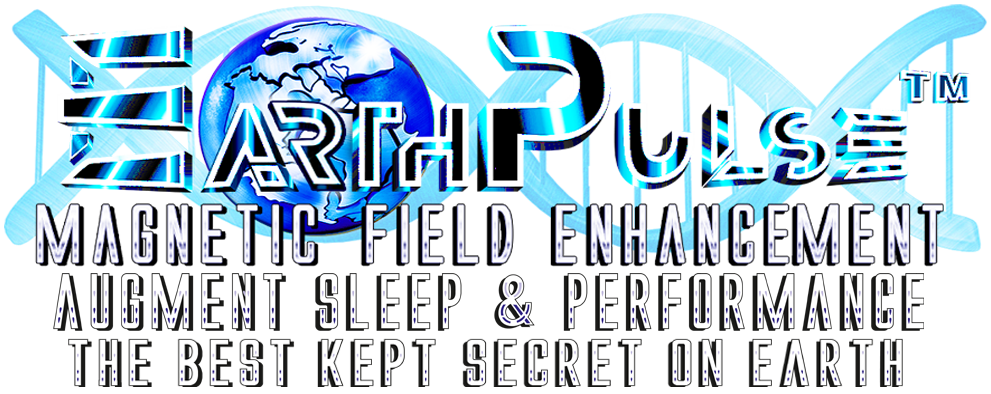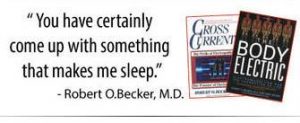Traumatic brain injury can be addressed through various energy healing methods. tDCS transcranial direct current stimulation, rTMS repetitive transcranial magnetic stimulation or PEMF pulsed electromagnetic field therapy.

Listen to astounding results from this patient after just 9 session on very high (20,000+ Gauss) PEMF clinically after just 9 sessions. A real life-changer.
One can not achieve these effects with a head-only therapy like rTMS repetitive transcranial magnetic stimulation or tDCS transcranial direct current stimulation or CES cranial electric stimulation. Notice the white “coil” wire winding around under his body. While the system type in the video generally create over 20,000 Gauss like rTMS, our experience is that one can get equally good (if not better) effects using lower amplitude PEMF for longer duration daily in the comfort of your own home.
See also Magnetic Therapy Post Traumatic Stress PTSD
Brain Stimulation for TBI Traumatic Brain Injury:
Neuromodulation. 2015 Nov 10. doi: 10.1111/ner.12364. [Epub ahead of print]
Repetitive Transcranial Magnetic Stimulation in Managing Mild Traumatic Brain Injury-Related Headaches.
Leung A1, Shukla S1, Fallah A1, Song D1, Lin L1, Golshan S1,2, Tsai A1, Jak A1, Polston G1, Lee R1.
Author information
Abstract
OBJECTIVE:
Headache is one of the most common debilitating chronic pain conditions in either active or retired military personnel with mild traumatic brain injury (MTBI). This study assessed the effect of repetitive transcranial magnetic stimulation (rTMS) in alleviating MTBI-related headache (MTBI-HA).
MATERIALS AND METHOD:
Veterans with MTBI-HA were randomized to receive either real rTMS (REAL group) at 10 hz for a total of 2000 pulses divided into 20 trains with one-sec inter-train interval or sham rTMS (SHAM group) at the left motor cortex (LMC) with brain magnetic resonance imaging neuronavigation guidance. Pretreatment, posttreatment one-week and four-week headache and neuropsychological assessments were conducted.
RESULT:
Thirty veterans were screened and twenty four (21 men and 3 women with average year-old ± SD at 14.3 ± 12.6) subjects’ data were analyzed. A two-factor (visit × treatment) repeated measures analysis of variance (RM-ANOVA) indicated a close to significant (p = 0.06) trend of interaction between pretreatment and posttreatment one-week assessment with the intensity of the persistent daily headache decreasing from 5.7 ± 1.9 to 2.2 ± 2.7 and 4.6 ± 1.3 to 3.5 ± 2.0 for the REAL and SHAM groups, respectively. Subsequent analyses indicated REAL group demonstrated a significantly (p = 0.041) higher % of reduction in persistent headache intensity than the SHAM group (56.3 ± 48.2% vs.15.4 ± 43.6%) at the posttreatment one-week assessment and the trend continued to the four-week assessment. Overall, a significantly (p = 0.035) higher percentage of the subjects in the REAL group (58.3%) demonstrated at least a 50% headache intensity reduction at posttreatment one-week assessment compared with the SHAM group (16.6%).
rTMS in Alleviating Mild TBI Related Headaches – A Case Series.
Leung A, Fallah A, Shukla S, Lin L, Tsia A, Song D, Polston G, Lee R.
Pain Physician. 2016 Feb;19(2):E347-54.
Non-pharmacological interventions for depression in adults and children with traumatic brain injury.
Gertler P, Tate RL, Cameron ID.
Cochrane Database Syst Rev. 2015 Dec 14;12:CD009871. doi: 10.1002/14651858.CD009871.pub2. Review.
Neville IS, Hayashi CY, El Hajj SA, Zaninotto AL, Sabino JP, Sousa LM Jr, Nagumo MM, Brunoni AR, Shieh BD, Amorim RL, Teixeira MJ, Paiva WS.
Trials. 2015 Oct 5;16:440. doi: 10.1186/s13063-015-0944-2.
No effects of 20 Hz-rTMS of the primary motor cortex in vegetative state: A randomised, sham-controlled study.
Cincotta M, Giovannelli F, Chiaramonti R, Bianco G, Godone M, Battista D, Cardinali C, Borgheresi A, Sighinolfi A, D’Avanzo AM, Breschi M, Dine Y, Lino M, Zaccara G, Viggiano MP, Rossi S.
Cortex. 2015 Oct;71:368-76. doi: 10.1016/j.cortex.2015.07.027. Epub 2015 Aug 4.
Effects of Repetitive Transcranial Magnetic Stimulation on Behavioral Recovery during Early Stage of Traumatic Brain Injury in Rats.
Yoon KJ, Lee YT, Chung PW, Lee YK, Kim DY, Chun MH.
J Korean Med Sci. 2015 Oct;30(10):1496-502. doi: 10.3346/jkms.2015.30.10.1496. Epub 2015 Sep 12.
Red Herring alert: 3000 pulses at 10 Hz = just 300 seconds (5 minutes) of rTMS per day.
Effect of Epidural Electrical Stimulation and Repetitive Transcranial Magnetic Stimulation in Rats With Diffuse Traumatic Brain Injury.
Yoon YS, Cho KH, Kim ES, Lee MS, Lee KJ.
Ann Rehabil Med. 2015 Jun;39(3):416-24. doi: 10.5535/arm.2015.39.3.416. Epub 2015 Jun 30.
Increases in microvascular perfusion and tissue oxygenation via pulsed electromagnetic fields in the healthy rat brain.
Bragin DE, Statom GL, Hagberg S, Nemoto EM.
J Neurosurg. 2015 May;122(5):1239-47. doi: 10.3171/2014.8.JNS132083. Epub 2014 Oct 24.
Preliminary guidelines for safe and effective use of repetitive transcranial magnetic stimulation in moderate to severe traumatic brain injury.
Nielson DM, McKnight CA, Patel RN, Kalnin AJ, Mysiw WJ.
Arch Phys Med Rehabil. 2015 Apr;96(4 Suppl):S138-44. doi: 10.1016/j.apmr.2014.09.010. Epub 2014 Oct 2.
Transcranial magnetic stimulation: A potential new treatment for depression associated with traumatic brain injury.
Reti IM, Schwarz N, Bower A, Tibbs M, Rao V.
Brain Inj. 2015;29(7-8):789-97. doi: 10.3109/02699052.2015.1009168. Epub 2015 May 7.
Non-Invasive Brain Stimulation for the Treatment of Symptoms Following Traumatic Brain Injury.
Dhaliwal SK, Meek BP, Modirrousta MM.
Front Psychiatry. 2015 Aug 26;6:119. doi: 10.3389/fpsyt.2015.00119. eCollection 2015. Review.
Noninvasive brain stimulation for persistent postconcussion symptoms in mild traumatic brain injury.
Koski L, Kolivakis T, Yu C, Chen JK, Delaney S, Ptito A. J
Neurotrauma. 2015 Jan 1;32(1):38-44. doi: 10.1089/neu.2014.3449.
Non-pharmacological interventions for chronic pain in people with spinal cord injury.
Boldt I, Eriks-Hoogland I, Brinkhof MW, de Bie R, Joggi D, von Elm E.
Cochrane Database Syst Rev. 2014 Nov 28;11:CD009177. doi: 10.1002/14651858.CD009177.pub2. Review.
Preliminary guidelines for safe and effective use of repetitive transcranial magnetic stimulation in moderate to severe traumatic brain injury.
Nielson DM, McKnight CA, Patel RN, Kalnin AJ, Mysiw WJ.
Arch Phys Med Rehabil. 2014 Oct 1. pii: S0003-9993(14)01116-2. doi: 10.1016/j.apmr.2014.09.010. [Epub ahead of print]
Transcranial magnetic stimulation: potential treatment for co-occurring alcohol, traumatic brain injuryand posttraumatic stress disorders.
Herrold AA, Kletzel SL, Harton BC, Chambers RA, Jordan N, Pape TL.
Neural Regen Res. 2014 Oct 1;9(19):1712-30. doi: 10.4103/1673-5374.143408. Review.
RTMS safety for two subjects with disordered consciousness after traumatic brain injury.
Pape TL, Rosenow JM, Patil V, Steiner M, Harton B, Guernon A, Herrold A, Pacheco M, Crisan E, Ashley WW Jr, Odle C, Park Y, Chawla J, Sarkar K.
Brain Stimul. 2014 Jul-Aug;7(4):620-2. doi: 10.1016/j.brs.2014.03.007. Epub 2014 Mar 26. No abstract available.
Neurocognitive brain response to transient impairment of Wernicke’s area.
Mason RA, Prat CS, Just MA.
Cereb Cortex. 2014 Jun;24(6):1474-84. doi: 10.1093/cercor/bhs423. Epub 2013 Jan 14.
A two-site pilot randomized 3 day trial of high dose left prefrontal repetitive transcranial magnetic stimulation (rTMS) for suicidal inpatients.
George MS, Raman R, Benedek DM, Pelic CG, Grammer GG, Stokes KT, Schmidt M, Spiegel C, Dealmeida N, Beaver KL, Borckardt JJ, Sun X, Jain S, Stein MB.
Brain Stimul. 2014 May-Jun;7(3):421-31. doi: 10.1016/j.brs.2014.03.006. Epub 2014 Mar 19.
Transcranial magnetic stimulation in brain injury.
Castel-Lacanal E, Tarri M, Loubinoux I, Gasq D, de Boissezon X, Marque P, Simonetta-Moreau M. Ann Fr
Anesth Reanim. 2014 Feb;33(2):83-7. doi: 10.1016/j.annfar.2013.11.006. Epub 2013 Dec 27. Review.
Disorders of consciousness and electrophysiological treatment strategies: a review of the literature and new perspectives.
Guerra A, Costantini EM, Maatta S, Ponzo D, Ferreri F.
Curr Pharm Des. 2014;20(26):4248-67.
Theta burst stimulation improves visuo-spatial attention in a patient with traumatic brain injury.
Bonnì S, Mastropasqua C, Bozzali M, Caltagirone C, Koch G.
Neurol Sci. 2013 Nov;34(11):2053-6. doi: 10.1007/s10072-013-1412-y. Epub 2013 Mar 27.
Effect of single-session repetitive transcranial magnetic stimulation applied over the hand versus leg motor area on pain after spinal cord injury.
Jetté F, Côté I, Meziane HB, Mercier C.
Neurorehabil Neural Repair. 2013 Sep;27(7):636-43. doi: 10.1177/1545968313484810. Epub 2013 Apr 11.
Low-frequency (1 Hz) repetitive transcranial magnetic stimulation (rTMS) reverses Aβ(1-42)-mediated memory deficits in rats.
Tan T, Xie J, Liu T, Chen X, Zheng X, Tong Z, Tian X.
Exp Gerontol. 2013 Aug;48(8):786-94. doi: 10.1016/j.exger.2013.05.001. Epub 2013 May 9.
rTMS in the management of allodynia from brachial plexus injuries.
Bertolucci F, Fanciullacci C, Rossi B, Chisari C.
Brain Stimul. 2013 Mar;6(2):218-9. doi: 10.1016/j.brs.2012.03.016. Epub 2012 Apr 12. No abstract available.
Benefit of multiple sessions of perilesional repetitive transcranial magnetic stimulation for an effective rehabilitation of visuospatial function.
Afifi L, Jarrett Rushmore R, Valero-Cabré A.
Eur J Neurosci. 2013 Feb;37(3):441-54. doi: 10.1111/ejn.12055. Epub 2012 Nov 21.
Repeated sessions of sub-threshold 20-Hz rTMS. Potential cumulative effects in a brain-injured patient.
Cavinato M, Iaia V, Piccione F.
Clin Neurophysiol. 2012 Sep;123(9):1893-5. doi: 10.1016/j.clinph.2012.02.066. Epub 2012 Mar 9. No abstract available.
Clinical applications of noninvasive electrical stimulation: problems and potential.
Rothwell JC.
Clin EEG Neurosci. 2012 Jul;43(3):209-14. doi: 10.1177/1550059412444973. Epub 2012 Apr 29.
Evaluation of differentiated neurotherapy programs for a patient after severe TBI and long term coma using event-related potentials.
Pachalska M, Łukowicz M, Kropotov JD, Herman-Sucharska I, Talar J.
Med Sci Monit. 2011 Oct;17(10):CS120-8.
Transcranial magnetic stimulation in cognitive rehabilitation.
Miniussi C, Rossini PM.
Neuropsychol Rehabil. 2011 Oct;21(5):579-601. doi: 10.1080/09602011.2011.562689. Epub 2011 Jun 24. Review.
Neurorehabil Neural Repair. 2011 Jan;25(1):98-102. doi: 10.1177/1545968310369802. Epub 2010 Jul 20.
Behavioral and neurophysiological effects of repetitive transcranial magnetic stimulation on the minimally conscious state: a case study.
Piccione F1, Cavinato M, Manganotti P, Formaggio E, Storti SF, Battistin L, Cagnin A, Tonin P, Dam M.
Development of quantitative and sensitive assessments of physiological and functional outcome during recovery from spinal cord injury: a clinical initiative.
Ellaway PH, Kuppuswamy A, Balasubramaniam AV, Maksimovic R, Gall A, Craggs MD, Mathias CJ, Bacon M, Prochazka A, Kowalczewski J, Conway BA, Galen S, Catton CJ, Allan DB, Curt A, Wirth B, van Hedel HJ.
Brain Res Bull. 2011 Mar 10;84(4-5):343-57. doi: 10.1016/j.brainresbull.2010.08.007. Epub 2010 Aug 20. Review.
Blast-induced electromagnetic fields in the brain from bone piezoelectricity.
Lee KY, Nyein MK, Moore DF, Joannopoulos JD, Socrate S, Imholt T, Radovitzky R, Johnson SG.
Neuroimage. 2011 Jan;54 Suppl 1:S30-6. doi: 10.1016/j.neuroimage.2010.05.042. Epub 2010 Jun 12.
TMS over the left angular gyrus impairs the ability to discriminate left from right.
Hirnstein M, Bayer U, Ellison A, Hausmann M.
Neuropsychologia. 2011 Jan;49(1):29-33. doi: 10.1016/j.neuropsychologia.2010.10.028. Epub 2010 Oct 28.
A case of post-traumatic complex auditory hallucinosis treated with rTMS.
Cosentino G, Giglia G, Palermo A, Panetta ML, Lo Baido R, Brighina F, Fierro B.
Neurocase. 2010 Jun;16(3):267-72. doi: 10.1080/13554790903456191. Epub 2010 Jan 25.
Repetitive transcranial magnetic stimulation-associated neurobehavioral gains during coma recovery.
Louise-Bender Pape T, Rosenow J, Lewis G, Ahmed G, Walker M, Guernon A, Roth H, Patil V.
BrainStimul. 2009 Jan;2(1):22-35. doi: 10.1016/j.brs.2008.09.004. Epub 2008 Oct 23.
The cortical basis of global motion detection in blindsight.
Alexander I, Cowey A.
Exp Brain Res. 2009 Jan;192(3):407-11. doi: 10.1007/s00221-008-1508-4. Epub 2008 Jul 30.
Perturbation of visuospatial attention by high-frequency offline rTMS.
Jin Y, Hilgetag CC.
Exp Brain Res. 2008 Jul;189(1):121-8. doi: 10.1007/s00221-008-1449-y. Epub 2008 Jun 19.
Virtual lesion of ventral premotor cortex impairs visual perception of biomechanically possible but not impossible actions.
Candidi M, Urgesi C, Ionta S, Aglioti SM.
Soc Neurosci. 2008;3(3-4):388-400. doi: 10.1080/17470910701676269.
Transcranial magnetic stimulation: a possible treatment for TBI.
Pape TL, Rosenow J, Lewis G. J Head Trauma Rehabil. 2006 Sep-Oct;21(5):437-51. Review.
Clin Neurophysiol. 1999 Jun;110(6):1080-9.
Dissociation of somatosensory and motor evoked potentials in non-comatose patients after head injury.
Chistyakov AV1, Hafner H, Soustiel JF, Trubnik M, Levy G, Feinsod M.
end – traumatic head injury / coma and PEMF database
You’ll have 90 days to try EarthPulse™ risk free.
No products can be sold relating to the bibliographies contained on this website























